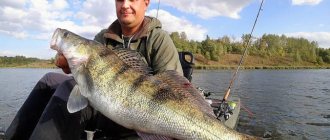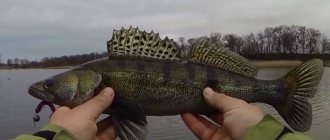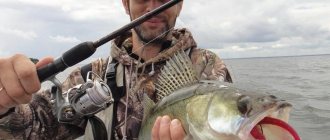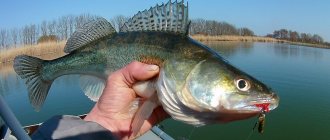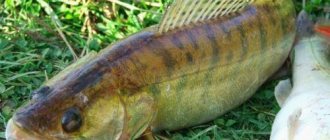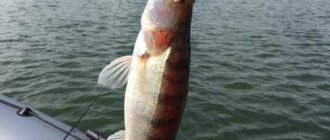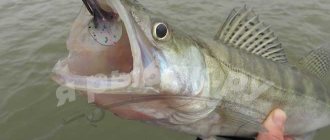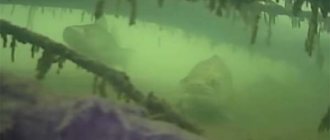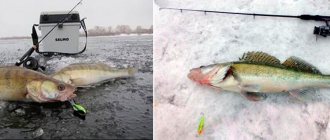The most popular equipment for catching pike perch in winter is considered to be a girder, but some fishermen use another equipment, a stand. This device is designed for passive hunting of predatory fish. If the bait has a special flag to signal a bite, then the bait for pike perch does not have such a detail, hooking is not carried out in this case, the fish clings to the hook itself.
Many fishermen consider this type of fishing to be a rather boring activity, but it is not the hooking of the fish, but the fishing technique that is particularly exciting. If desired and with a minimal investment of financial resources, anyone can make a supply. This type of gear can be used even by inexperienced fishermen in current or still water. In our article we will talk about what a stand is, learn about the equipment, the rules for selecting a place for catching pike perch and the technique for landing this fish.
Meaning of the term
The fishing term postavushka or passive girder indicates the simplest gear that is used to catch many types of predatory fish in the winter and summer seasons. Winter gear is not equipped with bite alarms, which are present in girders. Therefore, the fisherman can not be distracted by predators, but catch small fish with a jig rod. During winter fishing, you can catch pike perch, burbot, striped bass, large pike, and in some cases even trout.
When hunting for each of the fish described, it is necessary to take into account the behavior of each of the inhabitants of the reservoirs, lifestyle, and food supply. The main advantages of our gear over standard winter gear are:
- The ability to catch small fish with a jig without diverting attention to predatory fish, which usually happens when installing several girders;
- The fisherman can move freely around the reservoir in search of prey;
- Ease of manufacture and low cost of gear;
- The stand is installed under the ice, its base is securely fixed to the surface. This makes it possible for pike perch and other predatory fish to take bait without hindrance. When fishing with a zherlitsa, the line in the holes often freezes, so at the first jerk after resistance, a pike or pike perch can abandon the prey.
Advice! Any fisherman can install a signaling device on the equipment in question. To do this, tie a fishing line to two adjacent stands, and install a small branch in the middle of the span. The movement of this part will be a kind of signal about a bite.
Tackle for catching pike perch in winter
It’s possible to catch pike perch on sprat in winter using the following gear:
- On a fishing rod, for sheer trolling.
- To the girders.
- On postavushi.
Each option requires the use of certain equipment.
The role of the dead fish, in this case, is relegated to the background, since the entire fishing process is aimed at using artificial bait, such as:
- Spoon.
- Balance.
- Amphipod.
- A tube.
- Silicone.
- Rattlin.
The role of the sprat is to interest the predator with the aroma of small fish and lure it to the main bait.
A trolling rod can have the following design:
- A fishing rod, from 50 to 70 cm in size, with a hard whip and a light, comfortable handle.
- Light but large reel, both inertialess with a small reel and inertial simple.
- The diameter of the fishing line is selected from 0.22 to 0.28 mm. The fishing line must be monofilament, since braided line is afraid of low temperatures (it simply becomes “wooden” in the cold).
- An artificial bait from the list, to the hook of which a sprat is attached either in whole or in part. The hook chosen is strong and sharp. It is desirable that it be a tee.
Zherlitsa for pike perch
You can catch not only pike, but also pike perch with a zherlitsa, if you choose the right equipment. As a rule, when fishing with a girder, live fish (live bait) are used. If a dead fish is used, the tackle is called “postavusha”.
Where there is no current or it is too insignificant, then the usual “pike” installation is suitable:
- A sliding sinker is attached to a fishing line with a diameter of 0.3-0.35 mm. The weight of the sinker is selected in such a way that the live bait is at a height of 30 cm from the bottom and is held there.
- A silicone stopper is attached to the bottom of the load, which can be moved. This will allow you to change the distance to the hook. To catch pike perch, you do not need a special leash (as for pike). Pike perch is not able to bite through the fishing line.
- At the end of the tackle you need to tie a hook. As you know, the tee is more grippy, and the single is easier to remove from the mouth.
In the presence of a current, the vent has a completely different equipment:
- At the end of the main fishing line, a load of such weight is attached so that the tackle can be held in the current.
- At a distance of 30 cm from the load, a leash is attached using a triple swivel.
- A hook is attached to the leash.
When fishing with a zherlitsa, in addition to sprat, other types of fish are used. For example:
- Gudgeon.
- Bleak.
- Verkhovodka.
- Small roach, etc.
As mentioned above, postavusha is the same girder, only dead fish are used as bait. If there is a current, the design of the postavush is the same as in the zherlitsy. When fishing in stagnant water, as well as in the presence of a weak current, the installation of the hook is carried out as follows:
- A heavy jig or jig head is tied to the end of a fishing line 0.2 mm thick.
- 30-40 cm higher from the jig or jig head, a short leash with a hook is attached.
- The sprat is attached to both the jig and the hook.
We suggest you familiarize yourself with adjusting the temperature in a greenhouse with your own hands
The over-ice part of the postavushi consists of a winter fishing rod equipped with a large inertial reel, a powerful whip and a bright guard of a large size (relatively).
Postavushi, where sprat is used as bait, are installed in several pieces, which gives a much greater result, since it allows you to fish a larger area. By law, each angler must have no more than five. After installation, they walk around them hour by hour and little by little play along with them. To do this, the bait is torn off the bottom by about 40 cm and lowered to the bottom.
Most fishermen who catch predators using girders practice hole fishing with a spinner or jig. This way time passes much faster, and the catch may be larger.
To avoid this and other unpleasant situations, stock up and use the following devices:
- With a gapper you can easily open the mouth of a fish and fix it in this position. The device works as follows: the gapper is closed and placed in the pike's mouth (this is easy to do even if the mouth is closed). The device is then released and, thanks to a spring built inside, expands, leaving the predator's mouth open.
- Then you need to use an extractor or a medical clamp to remove the hook from the insides of the predator.
- To make it easier to remove large and active fish from a pond, you can use a landing net.
- To store caught predatory fish while you continue fishing, use a cukan or a rope on a wire.
Using a yawner will protect your hands from injury
Equipment supplied
Any fisherman makes each of the tackles in his own way, this also applies to the supply. However, the basic composition of the device in question includes the following parts:
- Reel made of plastic or rubber tube;
- Fishing line of a certain section;
- Sinker;
- Durable leash;
- Hook (double or tee).
When fishing for pike perch using baits, it is necessary to measure the depth of the reservoir. So, the length of the main line should be about a meter longer than this, which will prevent the predator from getting entangled in snags or coastal vegetation and breaking the leash. To limit the movements of the fish, a small incision is made in the reel material, where the fishing line is installed.
As we have already said, the supply is placed under the ice; this device must be fixed on the surface. For this purpose, a reel is used; a strong cord is tied to its central part. After lowering the rig, a wooden stick is threaded through the loop and placed in the middle of the hole.
Photo 1. The simplest installation.
How to make it yourself
The gear is quite simple, so each fisherman can make several deliveries at once. For the base or reel, it is recommended to take a 20 centimeter piece of rubber hose or plastic pipe, the length of the product is from 3 to 4 centimeters. At the next stage of work, it is necessary to wind a fishing line (about 7-8 meters) onto the reel, the cross-section of the thread is 3-5 millimeters. Next, install a sliding weight and a leash up to 1 meter long. At the final stage, a double or triple hook is tied. That's all, your supply is ready for use.
Photo 2. The delivery is ready for battle.
Fishing techniques, where to look for pike perch at different times of the year
The gear in question is used to catch pike perch most often at any time of the year. When using a sliding sinker, the predator does not feel its weight when attacking live bait. It is known that pike perch takes its prey from the bottom up; it is very careful and throws the bait at the slightest resistance. When using a sliding sinker, the predator will not feel resistance; it will swim a certain distance and turn the fry over in its mouth, swallowing the hook. That's when it's time to hook the fish.
The principle of operation of a sliding sinker is as follows. After throwing the tackle or lowering it into the hole in winter, the load pulls the tackle to the bottom, at the same time the live bait tries to move up. While the bait is moving, the weight still lies on the bottom, without limiting the movement of the fry. The weights used for delivery must be heavy enough. Their main task is to quickly deliver the bait to the bottom. Now let’s describe the habits of pike perch at different times of the year.
General requirements for gear for catching pike perch
Pike perch is a strong and tenacious predator. Its bony mouth and mass allow it to provide strong resistance during the fishing process.
The choice of gear for catching pike perch depends on the habitat of the prey.
Therefore, the best gear for catching pike perch should have the following characteristics:
- wear-resistant and durable fishing line;
- sharp and durable small hooks that can easily fall into the mouth and catch well;
- a rigid and powerful rod designed specifically for catching predators, as well as allowing you to confidently hook prey and successfully remove it;
- power traction coil.
Due to the fact that the fangs of pike perch are not very sharp, the possibility of cutting off the bait is minimal. In this regard, catchable tackle for pike perch does not require a leash.
Spinning fishing
It is recommended to purchase a lightweight, comfortable and easy-to-use fishing rod with a length of 2.4 to 3 meters. The length of the structure depends on the maximum casting distance. Preference should be given to models with rigid forms. When choosing a reel, you do not need to purchase expensive, complex products. A standard model made from reliable and durable materials will do. Size 2500-3000 would be ideal.
Regarding fishing line, braided type material is considered the most suitable option. The thickness should be in the range of 0.12-0.18 mm. As bait you can use wobblers, spinners, vibrating tails, fish made from silicone or foam rubber, as well as various insects and bugs.
One of the most popular is spinning fishing.
The most effective fishing for pike perch in the spring using a spinning rod from the shore begins in mid-April and lasts until the end of May. In the warm season, the predator concentrates in algae and reeds. It is recommended to carry out stepwise wiring, carried out with short and, at the same time, sharp movements.
Donk fishing
You cannot ignore the option of how to catch pike perch on a donk. It is believed that this method is not very common, but its correct and reasonable use at a certain period of the year can provide excellent results. At the height of summer and during cold weather, the predator is not particularly active, which plays into the hands of fishermen who use bottom gear.
It is considered that it is most suitable to use bottom tackle for pike perch at night. All that is required of the fisherman is to notice the bite in time (the process can take several hours, so it is recommended to leave the gear on the shore). Most often, the fish's reaction is observed before midnight or during dawn.
Donk fishing is not a very common method
Tackle for live bait fishing
This type of fishing is practiced in any weather. Live bait gear for pike perch can be in the form of a float rod, bottom devices, summer baits and other live baits. It is recommended to catch predators using poles during the cold season; at night, it is most effective to use fishing poles. Live bait can be gobies, perches, roaches, ruffes or minnows. No less than the above, the predator loves silver bream and white bream. In winter, crucian carp are a common baitfish as they are the easiest to find.
Tackle for pike perch using live bait may include special mugs, which are best used when fishing on a boat. The most suitable place would be a reservoir, that is, a place where there is no current. The predator is caught using mugs in the summer and early autumn.
Tackle for lure fishing
It is advisable to use spinners for pike perch in winter. This is an interesting, mobile, effective bait that makes it possible to catch vertebrates at depth and in hard-to-reach places. Narrow vibrators are recognized as the most effective. The weight, size and color of the product depends on the habitat of the fish. Rattlins should be used in ponds or rivers with a clean bottom. You can also use a balancer.
In winter, it is advisable to use a spoon for catching pike perch.
When to catch
It is best to catch pike perch at night. At this time, the fish in question is at a depth of 2 to 3 meters, it is hidden between underwater snags or stones. Disguised in such an ambush, the pike perch waits for prey. The predator is undemanding when it comes to its diet, but most often it hunts narrow species of fish. Usually its prey is minnows, bleaks, perch, and minnows.
Important! Pike perch lead a schooling lifestyle, so catching one of them indicates the proximity of other fish.
Most often, the described predators can be found in areas with turns in the current, on dumps or in places of artificial barriers.
in spring
In the spring, after spawning, pike perch actively feed in shallow water. Here they can spend the whole day, but such a habitat concerns only females. Male fish are guarding the spawning nest. From here they leave after the fry hatches from the eggs.
Two or three weeks after spawning, the females gain sufficient weight and begin to catch well. During this period, it is quite difficult to catch pike perch, as the fish disperse to different places. Grouping of predators into small flocks in pits occurs in the summer. Active pike perch bite is observed a month after spawning and it lasts only two, rarely three weeks.
In summer
With the onset of summer, when the sun begins to hit the eyes of the fish, the predators go into deep waters with a depth of 4 to 7 meters for the day; in the morning and evening they again appear in shallow water. During this period, they are attracted to flooded trees, snags and other shelters. It is in these places that you need to look for big trophies.
In some cases, predators can be found at shallow depths, up to 4 meters, and especially if the fish can hide from the midday sun in the shade of trees or behind boulders. In clean, deep lakes, large pike perch are especially careful; most of them are found at considerable depth.
in autumn
With the arrival of autumn, pike perch begins to lead a sedentary lifestyle. During this period, you can go through the day and not catch a single fish or end up with a rich catch. In general, fishing is unpredictable, but if you find a school of fish, a good catch will be guaranteed. In autumn, mostly females are found. This can be attributed to the fact that predators are actively feeding, preparing for the formation of eggs and further spring spawning. After the cold snap, pike perch continue to eat well, and by winter they gather in small groups.
in winter
The majority of pike perch can be caught on the first ice in winter. Bites of this fish in shallow waters can last up to a month. On deep lakes you can catch pike perch using a stand at the beginning and end of winter. The fish bite best at dusk or dawn at low pressure. A characteristic feature of winter fishing is the installation of girders on pike perch routes, places along which the predator moves in the winter and summer seasons.
Photo 3. Under the disk there is a tube with a cord.
Supply for pike perch in summer
With the arrival of summer heat and sunny days, bright light begins to cause some discomfort to the fish, so the pike perch goes to deep water, where the water thickness will be in the range of 4 to 7 meters.
In the morning or evening hours - before and after sunset, pike perch goes to shallow water, passing through the area of flooded trees and other shelters. This is where the largest specimens of fish pass.
Sometimes it happens that a predatory fish stands at a relatively shallow depth - about 3 meters. This happens if the area of the reservoir is located in the shade, for example, near trees or near stones. Large pike perch are well caught in summer in lakes; the fish there grow to very large sizes.
However, in such reservoirs it behaves as carefully as possible and prefers to live at great depths.
